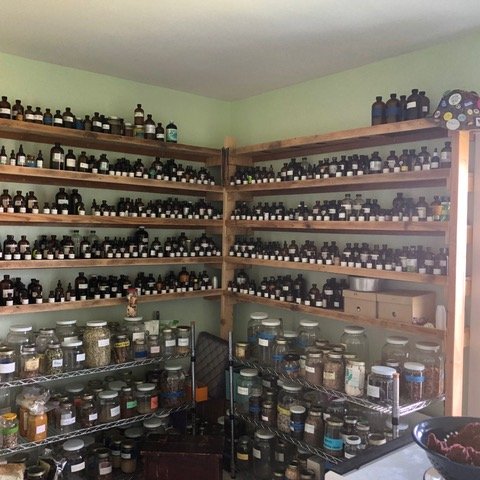Tracking herbs in my Herbal Storehouse
I was recently asked about how I keep track of herbs in my herbal storehouse. But first, a bit about semantics.
There are a number of legal restrictions regarding our language as [registered] herbalists. For example, we cannot use the words treat, diagnose, cure, prescribe or, latterly, the word prevent. Too, in some states, we cannot use the word apothecary. At times these legalities have felt constraining. However, over the many years that I have been working as a practicing clinical registered herbalist, verbal acrobatics have become second nature. Perhaps I have come to see these acrobatics as even freeing.
However, amidst all of these constraints, there is one word ~ apothecary ~ that I used to miss most of all. When I looked up its origins, my heart lept! From the Greek, αποθηκάρι (pronounced apothecary, meaning warehouse or storehouse). As a result, I have joyfully settled into the use of herbal storehouse and look forward to using this translation with gay abandon.
So … how do I keep track of herbs in my herbal storehouse? There’s lots to track, herbs that are drying; herbs that are resting in alcohols or vinegars or honey and have yet to be strained; oils too in varying states and yes, the tincture inventory on my shelves.
My present system is the result of trial and error and has evolved to work for me. As we are all our own herbalists, I can imagine that there are a multitude of systems. So let’s start with my shelves. Here are a few highlights.
The vast majority of bottles on my shelves are arranged by Latin (botanical) name. At one point, I labeled the shelves. That lasted about 10 seconds because as my storehouse grew, I needed to shift and adjust labels. It was a cumbersome, tedious, and time-consuming activity that began to occur relatively regularly.
I then created an inventory sheet, first a hard copy and later an electronic version. That lasted 20 seconds. If I did not immediately remember to adjust my records after blending each formula or sending out a simple, my inventory was inaccurate. Too, this didn’t avoid being surprised when I came upon empty bottles or, sadly, herbs disappearing from my shelves only to note their disappearance at a crucial time later. Nonetheless, I didn’t let go of this tracking system entirely.
Presently, a space for each of the simples on my shelves is held with a 1oz bottle. At a quick glance, I can see if something is missing or if a stock is low. I would say that this ‘scanning’ of my inventory of extracts now occurs each time I formulate. This system has been serving me for over a decade.
When it comes to dried herbs, if a glass container is empty, I turn it upside down on the shelf. This, too, is a quick and effective way for me to scan the contents of my storehouse and has been working fairly well for about 15 years.,
However, on a monthly basis, I return to a manual inventory. For each herb, I record a date, the volume of tincture on the shelf and the volume of dried herb. These are guesstimates. I estimate liquid volumes and dried masses. I also record herbs that I need to strain and bottle, as well as any dried herbs in reserve. An inventory entry might look like this for Achillea millifolium (yarrow).
From this simple, monthly record-keeping system, I can glean that I have dried herbs on my storehouse shelf. Also, I have plenty of dry herbs in reserve. I also know that I must’ve added to my dry reserve herb in storage. When it comes to a yarrow tincture, I know that I used about 250ml of herb over the preceding month, that I have about 500ml on the shelf, and about a further 400ml waiting to be strained. This system also helps me estimate my usage over time. For example, I use far more yarrow than I do licorice (Glycyrrhiza glabra). Therefore, when it comes to investing in my storehouse, i.e., wildcrafting or tincturing, I have a fair idea of where to spend my time and capital.
To be clear, an herbal storehouse is an investment and an investment worth contemplating. In addition to time and energy, there are the direct financial costs which include alcohol, bottles, labels, distilled waters, and, oh yes, herbs - both wildcrafted and purchased. There are the indirect costs of time and energies, including sourcing supplies, drying, glassware of all sorts, boxing, packaging, shipping, and, yes, record keeping.
My herbal storehouse is not a static entity. Is it a delight? Absolutely. While I am now only occasionally moved by the aroma of my storehouse, likely because I am in and out regularly, others remark on its luxurious aroma often.
Too, there is a pervading sense of calm in my storehouse. Its energies feel both rooted and expansive at the same time. Open and peaceful, perhaps best described as a welcoming aura of calm.
Topics such as whether or not to have an herbal storehouse or how to track contents are great topics to discuss with other herbalists or even a mentor. Sharing experiences and discussing alternatives can help to navigate successfully around pitfalls and increase ease as our practices grow.


